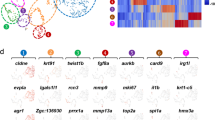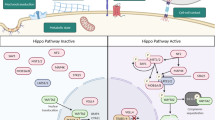Abstract
A major issue in regenerative medicine is the control of progenitor cell mobilisation. Apoptosis has been reported as playing a role in cell plasticity, and it has been recently shown that apoptosis is necessary for organ and appendage regeneration. In this context, we explore its possible mode of action in progenitor cell recruitment during adult regeneration in zebrafish. Here, we show that apoptosis inhibition impairs blastema formation and nerve growth, both of which can be restored by exogenous adenosine acting through its A2B receptor. Moreover, adenosine increases the number of progenitor cells. Purinergic signalling is therefore an early and essential event in the pathway from lesion to blastema formation and provides new targets for manipulating cell plasticity in the adult.





Similar content being viewed by others
References
Brockes JP, Kumar A (2008) Comparative aspects of animal regeneration. Annu Rev Cell Dev Biol 24:525–549
Galliot B, Ghila L (2010) Cell plasticity in homeostasis and regeneration. Mol Reprod Dev 77(10):837–855
Nakatani Y, Kawakami A, Kudo A (2007) Cellular and molecular processes of regeneration, with special emphasis on fish fins. Dev Growth Differ 49(2):145–154
Echeverri K, Tanaka EM (2002) Ectoderm to mesoderm lineage switching during axolotl tail regeneration. Science 298(5600):1993–1996
Tanaka EM (2003) Cell differentiation and cell fate during urodele tail and limb regeneration. Curr Opin Genet Dev 13(5):497–501
Kragl M, Knapp D, Nacu E, Khattak S, Maden M, Epperlein HH, Tanaka EM (2009) Cells keep a memory of their tissue origin during axolotl limb regeneration. Nature 460(7251):60–65
Cordeiro JV, Jacinto A (2013) The role of transcription-independent damage signals in the initiation of epithelial wound healing. Nat Rev Mol Cell Biol 14(4):249–262
Chera S, Ghila L, Dobretz K, Wenger Y, Bauer C, Buzgariu W, Martinou JC, Galliot B (2009) Apoptotic cells provide an unexpected source of Wnt3 signaling to drive hydra head regeneration. Dev Cell 17(2):279–289
King RS, Newmark PA (2012) The cell biology of regeneration. J Cell Biol 196(5):553–562
Gauron C, Rampon C, Bouzaffour M, Ipendey E, Teillon J, Volovitch M, Vriz S (2013) Sustained production of ROS triggers compensatory proliferation and is required for regeneration to proceed. Sci Rep 3:2084
Vriz S, Reiter S, Galliot B (2014) Cell death: a program to regenerate. Curr Top Dev Biol 108:121–151
Singer M (1974) Trophic functions of the neuron. VI. Other trophic systems. Neurotrophic control of limb regeneration in the newt. Ann N Y Acad Sci 228:308–322
Geraudie J, Singer M (1985) Necessity of an adequate nerve supply for regeneration of the amputated pectoral fin in the teleost Fundulus. J Exp Zool 234(3):367–374
Kumar A, Brockes JP (2012) Nerve dependence in tissue, organ, and appendage regeneration. Trends Neurosci 35(11):691–699
Poss KD (2010) Advances in understanding tissue regenerative capacity and mechanisms in animals. Nat Rev Genet 11(10):710–722
Sanchez Alvarado A, Yamanaka S (2014) Rethinking differentiation: stem cells, regeneration, and plasticity. Cell 157(1):110–119
Tseng AS, Adams DS, Qiu D, Koustubhan P, Levin M (2007) Apoptosis is required during early stages of tail regeneration in Xenopus laevis. Dev Biol 301(1):62–69
Morata G, Shlevkov E, Perez-Garijo A (2011) Mitogenic signaling from apoptotic cells in Drosophila. Dev Growth Differ 53(2):168–176
Ishida T, Nakajima T, Kudo A, Kawakami A (2010) Phosphorylation of Junb family proteins by the Jun N-terminal kinase supports tissue regeneration in zebrafish. Dev Biol 340(2):468–479
Li F, Huang Q, Chen J, Peng Y, Roop DR, Bedford JS, Li CY (2010) Apoptotic cells activate the “phoenix rising” pathway to promote wound healing and tissue regeneration. Sci Signal 3(110):ra13
Huang Q, Li F, Liu X, Li W, Shi W, Liu FF, O’Sullivan B, He Z, Peng Y, Tan AC, Zhou L, Shen J, Han G, Wang XJ, Thorburn J, Thorburn A, Jimeno A, Raben D, Bedford JS, Li CY (2011) Caspase 3-mediated stimulation of tumor cell repopulation during cancer radiotherapy. Nat Med 17(7):860–866
Mao P, Smith L, Xie W, Wang M (2013) Dying endothelial cells stimulate proliferation of malignant glioma cells via a caspase 3-mediated pathway. Oncol Lett 5(5):1615–1620
Chekeni FB, Elliott MR, Sandilos JK, Walk SF, Kinchen JM, Lazarowski ER, Armstrong AJ, Penuela S, Laird DW, Salvesen GS, Isakson BE, Bayliss DA, Ravichandran KS (2010) Pannexin 1 channels mediate ‘find-me’ signal release and membrane permeability during apoptosis. Nature 467(7317):863–867
Verkhratsky A, Burnstock G (2014) Biology of purinergic signalling: its ancient evolutionary roots, its omnipresence and its multiple functional significance. Bioessays
Burnstock G (2007) Purine and pyrimidine receptors. Cell Mol Life Sci 64(12):1471–1483
Zimmermann H (2000) Extracellular metabolism of ATP and other nucleotides. Naunyn Schmiedebergs Arch Pharmacol 362(4–5):299–309
Stagg J, Smyth MJ (2010) Extracellular adenosine triphosphate and adenosine in cancer. Oncogene 29(39):5346–5358
Elliott MR, Chekeni FB, Trampont PC, Lazarowski ER, Kadl A, Walk SF, Park D, Woodson RI, Ostankovich M, Sharma P, Lysiak JJ, Harden TK, Leitinger N, Ravichandran KS (2009) Nucleotides released by apoptotic cells act as a find-me signal to promote phagocytic clearance. Nature 461(7261):282–286
Godwin JW, Pinto AR, Rosenthal NA (2013) Macrophages are required for adult salamander limb regeneration. Proc Natl Acad Sci U S A 110(23):9415–9420
Huang WC, Yang CC, Chen IH, Liu YM, Chang SJ, Chuang YJ (2013) Treatment of glucocorticoids inhibited early immune responses and impaired cardiac repair in adult zebrafish. PLoS One 8(6):e66613
Li L, Yan B, Shi YQ, Zhang WQ, Wen ZL (2012) Live imaging reveals differing roles of macrophages and neutrophils during zebrafish tail fin regeneration. J Biol Chem 287(30):25353–25360
Deli T, Csernoch L (2008) Extracellular ATP and cancer: an overview with special reference to P2 purinergic receptors. Pathol Oncol Res 14(3):219–231
Burnstock G, Verkhratsky A (2010) Long-term (trophic) purinergic signalling: purinoceptors control cell proliferation, differentiation and death. Cell Death Dis 1:e9
Mondal BC, Mukherjee T, Mandal L, Evans CJ, Sinenko SA, Martinez-Agosto JA, Banerjee U (2011) Interaction between differentiating cell- and niche-derived signals in hematopoietic progenitor maintenance. Cell 147(7):1589–1600
Andersson O, Adams BA, Yoo D, Ellis GC, Gut P, Anderson RM, German MS, Stainier DY (2012) Adenosine signaling promotes regeneration of pancreatic beta cells in vivo. Cell Metab 15(6):885–894
Grau B, Eilert JC, Munck S, Harz H (2008) Adenosine induces growth-cone turning of sensory neurons. Purinergic Signal 4(4):357–364
Lecca D, Ceruti S, Fumagalli M, Abbracchio MP (2012) Purinergic trophic signalling in glial cells: functional effects and modulation of cell proliferation, differentiation, and death. Purinergic Signal 8(3):539–557
Burnstock G (2013) Introduction to purinergic signalling in the brain. Adv Exp Med Biol 986:1–12
Abbracchio MP, Burnstock G, Verkhratsky A, Zimmermann H (2009) Purinergic signalling in the nervous system: an overview. Trends Neurosci 32(1):19–29
Kumar A, Godwin JW, Gates PB, Garza-Garcia AA, Brockes JP (2007) Molecular basis for the nerve dependence of limb regeneration in an adult vertebrate. Science 318(5851):772–777
Masse K, Dale N (2012) Purines as potential morphogens during embryonic development. Purinergic Signal 8(3):503–521
Dal Santo G, Conterato GM, Barcellos LJ, Rosemberg DB, Piato AL (2014) Acute restraint stress induces an imbalance in the oxidative status of the zebrafish brain. Neurosci Lett 558:103–108
Piato AL, Rosemberg DB, Capiotti KM, Siebel AM, Herrmann AP, Ghisleni G, Vianna MR, Bogo MR, Lara DR, Bonan CD (2011) Acute restraint stress in zebrafish: behavioral parameters and purinergic signaling. Neurochem Res 36(10):1876–1886
Westerfield M (1995) The zebrafish book: a guide for the laboratory use of zebrafish (Brachydanio rerio). University of Oregon, Eugene
Dufourcq P, Vriz S (2006) The chemokine SDF-1 regulates blastema formation during zebrafish fin regeneration. Dev Genes Evol 216(10):635–639
Eltzschig HK (2009) Adenosine: an old drug newly discovered. Anesthesiology 111(4):904–915
Boehmler W, Petko J, Woll M, Frey C, Thisse B, Thisse C, Canfield VA, Levenson R (2009) Identification of zebrafish A2 adenosine receptors and expression in developing embryos. Gene Expr Patterns 9(3):144–151
Brockes JP (1997) Amphibian limb regeneration: rebuilding a complex structure. Science 276(5309):81–87
Stone TW (1981) Physiological roles for adenosine and adenosine 5′-triphosphate in the nervous system. Neuroscience 6(4):523–555
Dunwiddie TV, Masino SA (2001) The role and regulation of adenosine in the central nervous system. Annu Rev Neurosci 24:31–55
Christen B, Robles V, Raya M, Paramonov I, Belmonte JC (2010) Regeneration and reprogramming compared. BMC Biol 8:5
Maki N, Suetsugu-Maki R, Tarui H, Agata K, Del Rio-Tsonis K, Tsonis PA (2009) Expression of stem cell pluripotency factors during regeneration in newts. Dev Dyn 238(6):1613–1616
Knopf F, Hammond C, Chekuru A, Kurth T, Hans S, Weber CW, Mahatma G, Fisher S, Brand M, Schulte-Merker S, Weidinger G (2011) Bone regenerates via dedifferentiation of osteoblasts in the zebrafish fin. Dev Cell 20(5):713–724
Tu S, Johnson SL (2011) Fate restriction in the growing and regenerating zebrafish fin. Dev Cell 20(5):725–732
Sousa S, Afonso N, Bensimon-Brito A, Fonseca M, Simoes M, Leon J, Roehl H, Cancela ML, Jacinto A (2011) Differentiated skeletal cells contribute to blastema formation during zebrafish fin regeneration. Development 138(18):3897–3905
Singh SP, Holdway JE, Poss KD (2012) Regeneration of amputated zebrafish fin rays from de novo osteoblasts. Dev Cell 22(4):879–886
Stewart S, Stankunas K (2012) Limited dedifferentiation provides replacement tissue during zebrafish fin regeneration. Dev Biol 365(2):339–349
Fuchs Y, Steller H (2011) Programmed cell death in animal development and disease. Cell 147(4):742–758
Fredholm BB (2007) Adenosine, an endogenous distress signal, modulates tissue damage and repair. Cell Death Differ 14(7):1315–1323
Aherne CM, Kewley EM, Eltzschig HK (2011) The resurgence of A2B adenosine receptor signaling. Biochim Biophys Acta 1808(5):1329–1339
Lee DA, Knight MM, Campbell JJ, Bader DL (2011) Stem cell mechanobiology. J Cell Biochem 112(1):1–9
Sun Y, Chen CS, Fu J (2012) Forcing stem cells to behave: a biophysical perspective of the cellular microenvironment. Annu Rev Biophys 41:519–542
Acknowledgments
The authors thank Alain Prochiantz for the helpful discussions and constant support.
Author information
Authors and Affiliations
Corresponding author
Additional information
Christine Rampon and Carole Gauron contributed equally to this work.
Electronic supplementary material
Below is the link to the electronic supplementary material.
Fig. S1
Effect of AMP, ATP and adenosine receptor agonists and an antagonist on fin regeneration. Fish were incubated in drugs (nM) from the time of amputation to 3 dpa, and then the efficiency of regeneration was quantified and expressed as a percentage of the control. Representative fins are shown. Dotted lines indicate the amputation plane. Error bars represent the SEM (* p < 0.05, **p < 0.01, ***p < 0.001). n values were indicated on the bottom of each bar of the graph (JPEG 293 kb)
Rights and permissions
About this article
Cite this article
Rampon, C., Gauron, C., Meda, F. et al. Adenosine enhances progenitor cell recruitment and nerve growth via its A2B receptor during adult fin regeneration. Purinergic Signalling 10, 595–602 (2014). https://doi.org/10.1007/s11302-014-9420-9
Received:
Accepted:
Published:
Issue Date:
DOI: https://doi.org/10.1007/s11302-014-9420-9




